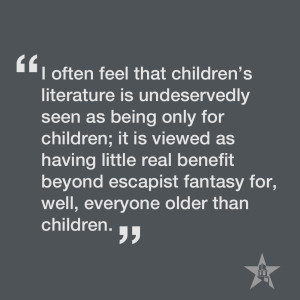The world, be that the broader world itself, the smaller college world, or one’s personal world, can be an overwhelming and complicated place – a milieu of clashing opinions, swirling emotions, and discouraging issues that can combine into a fog of confusion and uncertainty.
 Melodramatic as this image may seem, I don’t believe that it is a complete exaggeration of the chaos we can potentially encounter in our various worlds. In such situations, I and many others often find solace and inspiration through the power of stories. I doubt I need to proclaim the ability of books and stories to heal and to encourage, but I do think that many people overlook a deep mine of often-unexplored stories – the realm of children’s literature. After all, in the words of Madeline L’Engle, author of A Wrinkle in Time, “you have to write whichever book it is that wants to be written. And then, if it’s going to be too difficult for grown-ups, you write it for children.”
Melodramatic as this image may seem, I don’t believe that it is a complete exaggeration of the chaos we can potentially encounter in our various worlds. In such situations, I and many others often find solace and inspiration through the power of stories. I doubt I need to proclaim the ability of books and stories to heal and to encourage, but I do think that many people overlook a deep mine of often-unexplored stories – the realm of children’s literature. After all, in the words of Madeline L’Engle, author of A Wrinkle in Time, “you have to write whichever book it is that wants to be written. And then, if it’s going to be too difficult for grown-ups, you write it for children.”
I often feel that children’s literature is undeservedly seen as being only for children; it is viewed as having little real benefit beyond escapist fantasy for, well, everyone older than children. However, my twelve years working and volunteering at my local library have made me view these books differently. Over that span of time, I have seen many adults discovering (or rediscovering in some cases) new friends among the set of books that make their home in the children’s section. These books resonate with adults as well as children because, in many cases, they tackle topics and themes equally as mature as many “adult” books, but they approach them in a more straightforward and compassionate manner.
Looking for a book that thoughtfully examines themes of youth, age, and life and death? Try Natalie Babbit’s Tuck Everlasting. Maybe a story about loss, trauma, and the healing power of nature is more the type of book you need? Nothing can beat Francis Hodgson Burnett’s The Secret Garden. Or what about a tale of unconditional love and acceptance of yourself for who you are instead of who you wish you were? Allow me to point you towards my very dear friend, The Velveteen Rabbit by Margery Williams. These books and hundreds more like them may veil their thought-provoking stories, characters, and emotions behind their simplicity and gentle beauty, but their power to touch the souls of readers is just as strong as their more grown-up counterparts.
Along with the wonderful classics of children’s literature past, a short glance at recent winners of the American Library Association’s Youth Media Awards reveals dozens of complex contemporary stories that, in addition to their high literary quality, confront a wide spectrum of issues and themes ranging from love and imagination to race and identity.
Children’s books can encourage one to engage a thought-provoking topic through a unique lens, recharge a tired imagination, galvanize the spirit, and refresh the soul by directly confronting the core ideas and emotions of a story. Furthermore, due to their accessible writing and generally compact style, many of these books can be fit into even the busiest of schedules.
So in addition to sharing these stories with the children in your life, perhaps you should pick one up for yourself, be it a recent addition to the “kidlit” canon or a revisit to a one-time literary friend. In a world that sometimes appears to hold a seriously deficit when it comes to hope and possibility, children’s literature can be a helpful reminder that, in the words of The Secret Garden, “if you look the right way, you can see that the whole world is a garden.” And what a beautiful garden it can be.

